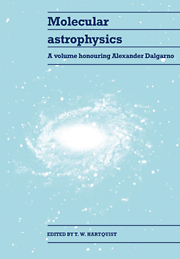Book contents
- Frontmatter
- Contents
- Dedication
- Preface
- Part I Molecular clouds and the distribution of molecules in the Milky Way and other galaxies
- Part II Diffuse molecular clouds
- Part III Quiescent dense clouds
- Part IV Studies of molecular processes
- 9 Molecular photoabsorption processes
- 10 Interstellar ion chemistry: laboratory studies
- 11 Theoretical considerations on some collision processes
- 12 Collisional excitation processes
- 13 Neutral reactions at low and high temperatures
- Part V Atomic species in dense clouds
- Part VI H2 in regions of massive star formation
- Part VII Molecules near stars and in stellar ejecta
- Part VIII Moderately ionized gas and chemistry at large redshifts
- Index
9 - Molecular photoabsorption processes
Published online by Cambridge University Press: 10 December 2009
- Frontmatter
- Contents
- Dedication
- Preface
- Part I Molecular clouds and the distribution of molecules in the Milky Way and other galaxies
- Part II Diffuse molecular clouds
- Part III Quiescent dense clouds
- Part IV Studies of molecular processes
- 9 Molecular photoabsorption processes
- 10 Interstellar ion chemistry: laboratory studies
- 11 Theoretical considerations on some collision processes
- 12 Collisional excitation processes
- 13 Neutral reactions at low and high temperatures
- Part V Atomic species in dense clouds
- Part VI H2 in regions of massive star formation
- Part VII Molecules near stars and in stellar ejecta
- Part VIII Moderately ionized gas and chemistry at large redshifts
- Index
Summary
Introduction
Molecules have been found to exist in a rich variety of astrophysical environments, including stellar atmospheres, comets, planetary atmospheres, and the dense and diffuse clouds in the interstellar medium. An understanding of molecular structure, spectroscopy, and photoabsorption processes is thus of critical importance in interpreting many of the current observations, in theoretically modeling these various astrophysical regions, and in judging the reliability of the available molecular data. Even in our own atmosphere, considerations of molecular photoabsorption determine ‘windows’ in the electromagnetic spectrum in which one can carry out ground-based observations. Accurate molecular spectroscopic data derived from laboratory experiments or theoretical calculations are necessary in order both to identify molecular species and to quantify abundances of these species from the observed absorption line wavelengths and intensities, respectively.
The vibrational and rotational nuclear degrees of freedom add significantly to the spectroscopic complexity of a molecule compared with an atom. As in an atom, transitions between different electronic energy levels in a molecule are generally observed at optical (4000–6000 Å) and ultraviolet (800–4000 Å) wavelengths, whereas transitions between vibrational energy levels and rotational energy levels generally take place in the infrared region (2–20 µm) and microwave region (λ > 0.2 mm) of the electromagnetic spectrum, respectively. This range of energies over which molecules are responsive to radiation makes them valuable as sensitive probes of the physical conditions of the astrophysical environments in which they are found.
- Type
- Chapter
- Information
- Molecular AstrophysicsA Volume Honouring Alexander Dalgarno, pp. 159 - 180Publisher: Cambridge University PressPrint publication year: 1990
- 14
- Cited by

